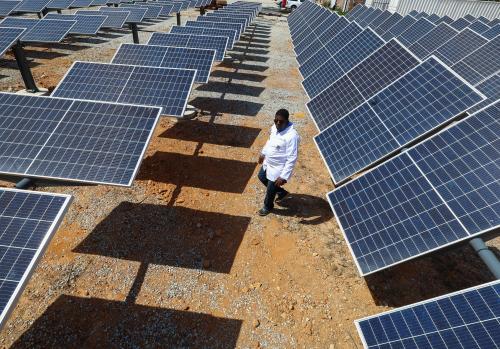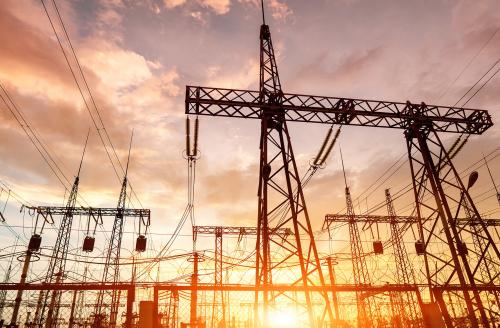Policymakers and advocates working to reduce the impacts of climate change have a difficult tightrope to walk: trying to raise public awareness about the scale and urgency of the problem without terrifying people into paralysis. One way to encourage productive conversations is to balance explanations of risks with concrete, feasible solutions. A new book from Carolyn Kousky, “Understanding Disaster Insurance: New Tools for a More Resilient Future,” provides an excellent example of how to do this.
The book explains how well-designed insurance products can provide financial support to households and businesses that are impacted by climate-related events such as intense storms, wildfires, and earthquakes, and highlights the limitations to our current insurance markets and programs. Some of the material is fairly technical and gets into the weeds of complex financial instruments (who hasn’t heard of parametric microinsurance?). But three big-picture takeaways are quite straightforward—and deserve greater attention from policymakers and voters.
Most American homes and families are underinsured against climate-related stresses
Readers may wonder: Why is it necessary to have special insurance for disasters? Two-thirds of Americans own their homes, and mortgage lenders require borrowers to buy property insurance at the time of purchase to protect the lender’s investment. While typical homeowners’ insurance covers some physical damages from weather (like a tree falling onto the roof), policies expressly do not cover disasters such as floods (often the most expensive damage from hurricanes) or earthquakes. Chapter 2 of “Understanding Disaster Insurance” contains some eye-opening statistics on insurance gaps:
- Across North America, only 40% of economic losses from disasters are insured.
- Among households who live in the 100-year flood plain designated by the Federal Emergency Management Agency, only about 30% have flood insurance.
- Slightly more than 10% of California homeowners have earthquake insurance.
- Only 40% of renters have renters’ insurance.
Even for households that have disaster insurance, their policies often do not cover the full cost of damages. Policies may have high deductibles that homeowners must pay out of pocket before insurance kicks in. Caps on the total reimbursement amount may be lower than the costs of repairs needed. A common problem is that consumers insure their home for the market value at the time of purchase, and do not update the value of the property or their belongings over time. Public insurance programs such as the federal National Flood Insurance Program and Community Development Block Grant Disaster Recovery program fill some of the gaps, but also typically fall well short of the total cost of damages.
The fragmented system of disaster insurance and recovery means that the financial costs are distributed across many people, private companies, public agencies, and taxpayers. Climate disasters also have economic repercussions for surrounding communities and the broader financial system. And families affected by natural disasters face long-term financial risks, including mortgage default and declining credit scores.
The complexity of buying disaster insurance deters consumers
A core tenet of well-functioning markets is that consumers are able to make well-informed, rational decisions about their purchases based on how much they value a good or service. But disaster insurance is a clear example of a service where consumers lack key pieces of information that allow them to determine whether they should purchase insurance against a particular climate event and at what price. Specifically, what is the likelihood that the climate event will occur, and how much damage will it cause? Insurance companies develop estimates based on historical events and statistical modeling, but this information is rarely shared with consumers. Even small differences in assumptions can make insurance a “good” or “bad” purchase, as shown in the hypothetical examples below.
Let’s say that the annual premium for flood insurance is $150. Scenario 1 estimates that the probability of a flood occurring is 1%, and the flood would cause $10,000 worth of damage to a home. That means that the expected value of damage is 1% x $10,000, or $100. A risk-neutral customer would not choose to pay $150 for flood insurance, because the annual premium exceeds the expected value of damages. (A risk-averse customer would be willing to pay more than $100 for flood insurance, but probably still less than $150.)

But what if the estimate of the flood damage is too low? Scenario 2 estimates that the flood causes $20,000 worth of damage. Now the expected value of damage is $200, so a risk-neutral customer would be willing to pay $150 in annual premiums. And Scenario 3 shows that increasing the probability of flooding to 5% while keeping damage costs at $10,000 also makes the $150 flood insurance premium a good purchase.
Even with the best climate data and analytics available today, there is considerable uncertainty about when and where disasters will occur and how severe they will be, especially as the climate changes over time. Many consumers find the pricing of insurance opaque and do not understand the underlying math. And most people prefer not to think about unpleasant events, let alone spend money in expectation of them.
In short, if policymakers want more households to be covered by disaster insurance, relying on voluntary purchases won’t get the job done. The book points out that in other countries, disaster insurance is included in standard homeowners’ policies, which gets around the need for households to make separate purchase decisions. Lessons can also be drawn from mortgage markets: As a result of the 2007-2009 foreclosure crisis, federal regulators now require mortgage lenders to provide a standardized one-page disclosure form summarizing key loan features to help borrowers understand their purchase. However, unlike mortgages, insurance is regulated by state governments rather than federal agencies, so such policies would likely require state-by-state action.
Disaster insurance complements—but does not replace—efforts to reduce risk
Although the primary focus of “Understanding Disaster Insurance” is the mechanics of how to create better insurance products, the author underscores that insurance is only part of the broader approach to climate change. As one of the most memorable lines in the book puts it: “We want to prevent dead cows, not pay for them once they are gone.” This means we should undertake investments that reduce the probability of disasters, and limit the extent of damage when they occur.
A variety of strategies could reduce the climate risks homes and neighborhoods face. Some strategies are expensive, such as elevating homes in high-flood-risk areas, but others have modest upfront costs. Insurance policies can be designed to incentivize property owners to undertake some of these investments. For instance, some policies offer reduced annual premiums to homeowners who fortify their roofs against hurricane winds or prune trees near homes in wildfire zones (both relatively inexpensive tasks). But low-income households with limited access to credit will have difficulty paying for even small investments, so may require direct grants from public agencies to cover the costs. And some risk reduction efforts will be expensive and politically unpopular, like relocating entire communities or designating no-build areas in places at highest risk.
Increasing the physical and financial climate resilience of U.S. homes and neighborhoods is an urgent task that will require concerted efforts by policymakers at all levels of government as well as private companies in insurance, housing, and financial services. An important first step is increasing awareness among voters and policymakers; books like “Understanding Disaster Insurance” that make these issues tangible and accessible are part of that process.
Full disclosure: Carolyn Kousky is a non-resident senior fellow at Brookings Metro and was a classmate of Jenny Schuetz in graduate school. She was not involved in the writing of this piece.




Commentary
A new book details how disaster insurance can enhance climate and financial resilience for homes and neighborhoods
December 20, 2022